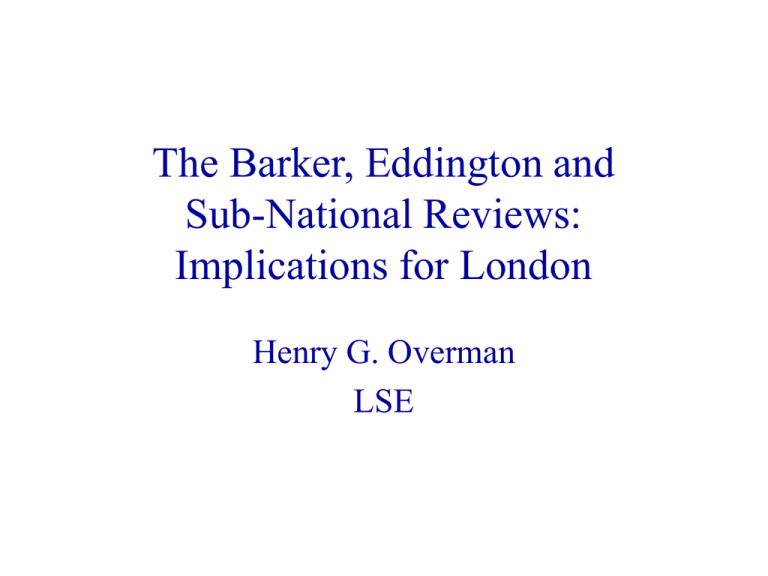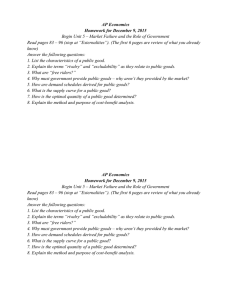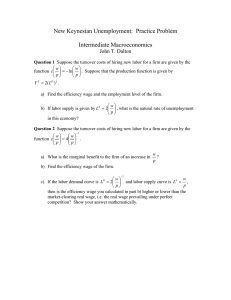The Barker, Eddington and Sub-National Reviews: Implications for London Henry G. Overman
advertisement

The Barker, Eddington and Sub-National Reviews: Implications for London Henry G. Overman LSE Overview • What are the reviews about? • How do they fit together – The relevant recommendations – The potential for conflict with the sub-national review • The impact on our successful cities • What to do about our disadvantaged communities The Barker Review • To consider how planning policy / procedures can better deliver economic growth alongside other sustainable development goals. To assess: – – – – Efficiency and speed Flexibility, transparency and predictability Productivity and sustainability “the relationship between economic and other sustainable development goals in the delivery of sustainable communities” Eddington Study • “Examine the long-term links between transport and the UK's economic productivity, growth and stability, within the context of the Government's broader commitment to sustainable development.” Barker recommendations • More role for the market and (slightly) less constraints – Updating national policy […] to ensure that the benefits of development are fully taken into account […] with a more explicit role for market and price signals – Ensuring that new development beyond towns & cities occurs in the most sustainable way, by encouraging planning bodies to review green belt boundaries […] – Supporting the ‘town-centre first’ policy, but removing the requirement to demonstrate the need for development; Eddington recommendations • […] focus on improving the performance of existing transport networks, in those places that are important to the UK’s economic success • […] the three strategic economic priorities for transport policy should be – congested and growing urban areas and their catchments – the key inter-urban corridors – the key international gateways • [...] Policy should get the prices right (especially congestion pricing on the roads and environmental pricing across all modes) and make best use of existing networks Congestion: Impact of road pricing 2025 Without With The Sub-national review • How to further improve (sic) existing sub-national structures in England to make sure achieve PSA’s: – PSA2: Make sustainable improvements in the economic performance of all English regions by 2008, and over the long term reduce the persistent gap in growth rates between the regions, demonstrating progress by 2006 [, including by establishing Elected Regional Assemblies in regions which vote in a referendum to have one.] – PSA1: Tackle social exclusion and deliver neighbourhood renewal, […] , in particular narrowing the gap in health, education, crime, worklessness, housing and liveability outcomes between the most deprived areas and the rest of England, with measurable improvement by 2010. Implications of E&B? • Depends on how you think about causes and consequences of spatial disparities • Two “clear” justifications for dealing with spatial disparities – “It’s just not fair” – “Everyone’s a winner” Equity and efficiency • At the heart of debates over economic justification for LED policy – Equity – Efficiency • “It’s just not fair” equity role • “Everyone’s a winner” efficiency role • PSA 2 claims both Neoclassical growth models • Output per worker a function of supply of factors of production – Physical capital (private or public) – Human capital (“skills”) – Technology Predictions • Decreasing returns Convergence • Long run differences driven by – Technology • Factor mobility reinforces convergence – Capital flows to capital scarce regions – Labour flow to labour scarce regions • With factor mobility long run differences driven by technology Adjustment: Leave to markets but…. • “The persistence of these differentials over large parts of the last century, points to significant market failures in under-performing regions and localities. If the economic processes driving growth were working effectively, we would expect these differences to disappear over time.” [HMT Productivity 3] • Market failures – Capital mobility – Indigenous investment E&B in a neo-classical world • Barker argues for focus on externalities (i.e. market failure) but then pay more attention to market signals • Eddington suggests pricing congestion (i.e. market failure) and using market as signal for need for investment • Leave to markets but … • No direct conflict with PSA 2 Economic geography • Evidence of increasing (not decreasing) returns to geographical concentration • Location outcomes are a balance between – Agglomeration forces (benefits of proximity) – Dispersion forces (costs of proximity) • What are the implications for PSA 2 and PSA 1? Simple diagrammatic framework • Can demonstrate forces in simple diagram • Wage curve – How wages change with city size • Cost curve – How costs change with city size The wage curve • Wage increases with city size • Aggregate increasing returns consistent with lots of micro-economic foundations • Shape depends on exact model Cost of living curve • Components – Commuting (increasing with N) – Housing (increasing with N) – Other (tradable) goods (ignore for the moment) • Second order effects? – Wage to cost of commuting – Wage to demand for housing Labour supply and equilibrium • Labour supply – Perfect versus imperfect mobility – Amenities can shift up or down • Equilibrium – A unstable – C stable Does a large London matter? • It may be efficient and equitable to have a large London. • People care about real not nominal wages • Extreme assumption that people perfectly mobile real wages equalised • Strength of agglomeration externality determines city size • Places are different sizes with different nominal wages Market failures • Potential inefficiencies – People may not be mobile • Propensities versus flows in a world with lots of land constraints – Places are too big relative to the optimum “Coordinating” role? – There are externalities Fix externalities A more realistic labour supply curve Mobility and land use • Encouraging mobility makes London bigger, but narrows real wage disparities • Getting land use constraints wrong can be very costly – Before considering whether we have them wrong, need to consider externalities Externalities • There are externalities so optimal net wage curve may be higher or lower • Eddington price congestion – Traditionally, focus has been on what this does to the cost curve – But also affects wage curve – Overall effect ambiguous Fixing externalities E&B and a larger London • Price in congestion • Allow market signals to influence land use Market signals so extreme (275:1 SE: 400-800:1 Reading) that congestion (and other externalities) need to be massive for a smaller London to be efficient • What about compositional effects? Composition effects • Differences in outcome for skilled and unskilled workers reflects equilibrium sorting not market failures • Costs of “mixed” communities – Segregated communities preferred by both skilled and unskilled. • Implication for PSA’s 1 & 2 – All regions/neighbourhoods to look alike in terms of skill composition – Big efficiency costs • Role of sorting also overlooked in discussions of implications of infrastructure for regeneration People versus places • Difference between people and places • The mobile gain from spatial concentration • No market failure here – so you are making a straight redistributive choice • Once allow for traded goods, may not even be an equity basis for spatial policy • It is even possible that policy should encourage more uneven development not less! Conclusions • Need to understand the economic mechanisms that are leading to uneven development • Price effects and income effects important (many people ignore former) • Need to be explicit about our welfare criteria – Changes that enhance inequality but also increase the income of people in the poorest region? – People versus places Conclusions • More thought / evidence needed – – – – – Nature of increasing returns Composition effects Mobility Land use constraints Externalities Conclusions • Strength of agglomeration externality determines city size • Places are different sizes with different nominal wages • Imperfect labour mobility leads to differences in real wages • Targeting certain market failures may be win-win but others may increase efficiency and bring more uneven spatial development Linkages between places: NEG • NEG: • Increasing returns to scale • Transport costs between regions • Some workers/consumers dispersed and tied to particular places Intuition • With IRS, prefer to build one plant • Benefits of locating in large market – Cost linkages – Demand linkages • Costs of locating in large market – Product market competition – Factor market competition The role of transaction costs • Changing transport costs changes balance of agglomeration and dispersion forces • Key - product market competition from the other market increases as transport costs fall – High transport costs, firms in small markets protected from competition; in large markets more competition – As transport costs fall, firms everywhere face more competition dispersion force less strong • Agglomeration as transport costs fall







